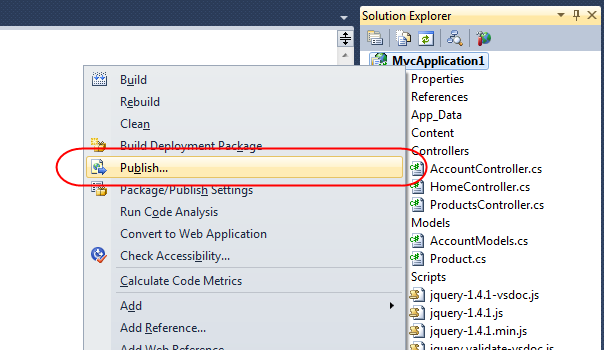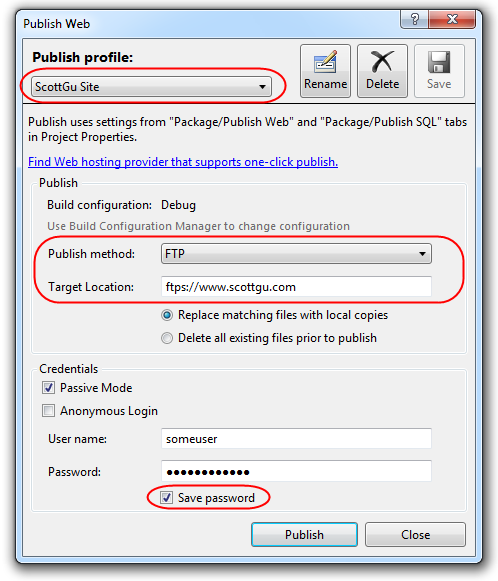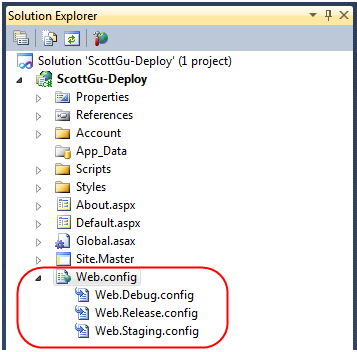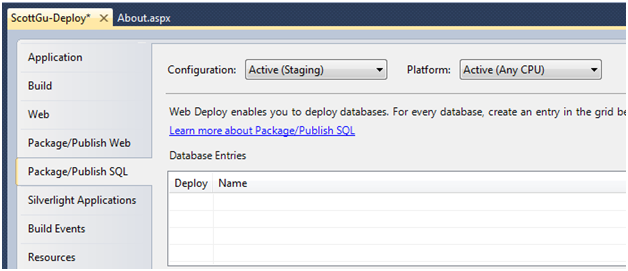VS 2010 Web Deployment
This is the twenty-fifth in a series of blog posts I’m doing on the VS 2010 and .NET 4 release.
Today’s blog post is the first of several posts I’ll be doing that cover some of the improvements we’ve made around web deployment. I’ll provide a high-level overview of some of the key improvements. Subsequent posts will then go into more details about each feature and how best to take advantage of them.
Making Web Deployment Easier
Deploying your web application to a server is something that all (successful) projects need to do. Without good tools to help you, deployment can be a cumbersome task – especially if you need to do it manually.
VS 2010 includes a bunch of improvements that make it much easier to deploy your ASP.NET web applications – and which enable you to build automated deployment procedures that make deployment easily reproducible. The deployment features support not just deploying your web content – but also support customizing your web.config file settings, deploying/updating your databases, and managing your other dependencies. You can kick-off deployments manually – or via automated scripts or as part of an automated build or continuous integration process.
Below is a high-level overview of some of the key new web deployment features in VS 2010. I’ll do subsequent posts that provide more details on how to use/customize each of them.
New “Publish Web” Dialog
Visual Studio 2010 includes a new “Publish Web” dialog that you can use to quickly deploy a web application to a remote server.
You can activate the dialog by right-clicking on an ASP.NET Web Project node within the solution explorer, and then select the “Publish” context menu item:
Selecting this will bring up a “Publish Web” dialog which allows you to configure publish location settings.
Configuring and Saving a Publish Profile
You only need to define your publish settings once – you can then save them as a named “Publish Profile” to enable you to quickly re-use them again later.
Above I’ve created a “ScottGu Site” profile, and configured it to deploy via FTPS (a version of FTP that uses SSL) to a remote server. To deploy over FTPS select the “FTP” node in the drop-down, and then prefix the server location you want to publish to with the “ftps://” prefix.
Note that you can either re-enter your password each time you deploy – or save the password for future uses in a secure location (just click the “Save Password” checkbox to do this.
Web Deploy
In addition to supporting FTP/FTPS, VS 2010 also supports a more powerful publish mechanism called “Web Deploy”. Web Deploy (earlier known as MSDeploy) provides a much more comprehensive publishing and deployment mechanism than FTP. It not only allows you to publish files, but also allows you to publish IIS Web Server Settings, Database Schema/Data, Database Change Scripts, Security ACLs, and much more.
Web Deploy can be used to deploy applications both to a single server, as well as to multiple servers within a web farm. Web Deploy is also now supported by many inexpensive Windows hosting providers (some as cheap as $3.50/month for an ASP.NET + SQL account). You can find great ASP.NET hosters that support Web Deploy by visiting this page: http://asp.net/find-a-hoster.
One Click Publish Toolbar
Clicking the “Publish” button within the “Publish Web” dialog will publish a web application (and optionally associated database schema/content) to a remote web server.
VS 2010 also supports a “one click” publish toolbar that you can add to your IDE to quickly publish/re-publish your project without having to load the “Publish Web” dialog:
Just select your publish profile from the toolbar drop-down and then click the publish icon to the right of it to begin deploying your application.
Web.Config Transformations
In most real-world deployment scenarios, the web.config file you use for development is different than the one you use for production deployment. Typically you want to change environment settings like database connection-strings, making sure debug is turned off, and enabling custom errors so that end-users (and hackers) don’t see the internals of your application.
VS 2010 now makes it easy to customize/tweak/modify your web.config files as part of your publish/deployment process. Specifically, you can now easily have build-configuration specific transformation files that can customize your web.config file prior to the application being deployed:
You can maintain a separate transform file per Visual Studio build-environment. For example, you could configure your project/solution to have a “Debug”, “Staging” and “Release” build configuration – in which case VS will maintain three separate transform files for you. VS will automatically apply the appropriate one at deployment time depending on what your VS environment is set to.
I will dive deeper into how to perform web.config file transformations in a future blog post.
Database Deployment
VS 2010 allows you to optionally deploy a database, along with your web application files, when are using the “Web Deploy” option as your deployment mechanism. Databases deployed this way can include both schema and data, and can optionally also include change scripts to update existing databases.
ASP.NET Web Projects in VS 2010 have a special page within their the “project properties” settings to configure database deployments:
I will dive deeper into how to perform database deployments in future blog posts.
Web Deployment Packages
VS 2010 also supports a packaging option that enables you to package up your ASP.NET Web Application (together with its dependencies like web.config, databases, ACLs, etc) into a .zip based deployment package file that you can optionally hand-off to an IT administrator who can then easily install it either via the IIS Admin Tool or via a command-line/powershell script.
The deployment package you create can optionally expose application configuration settings that can be overridden (like directory locations, database connection-strings, etc). When using the IIS7 Admin Tool, the install wizard can prompt the administrator for each setting to be customized – enabling you to provide a clean customization experience without having to write any custom code to-do so. The settings can also obviously be passed as arguments on the command-line when using a command-line or Powershell script to deploy the application.
To create a web package within Visual Studio 2010, just right click on your ASP.NET Web Project node in the solution explorer and select the “Build Deployment Package” menu item:
This will compile your application, perform appropriate web.config transforms on it, optionally create .sql scripts for your database schema and data files, and then package them all up into a .zip deployment package file. Adjacent to the .zip file you’ll file a deployment script file that you can use to automate deployment of the package to a remote server.
I will dive deeper into how to create web deployment packages in future blog posts.
Continuous Integration with Team Build
Most of the VS 2010 web deployment features that I described above are built on top of MSBuild tasks & targets. The “Team Build” feature of TFS also uses MSBuild, and supports running nightly builds, rolling builds, and enabling continuous integration. This means that you can create deployment packages, or automatically publish your web applications from a Team Build environment.
I will dive deeper into how to enable this in future blog posts.
Summary
Today’s blog post covered some of the new VS 2010 web deployment features at a high-level. All of the above features Iwork with both VS 2010 as well as the free Visual Web Developer 2010 Express Edition.
Hopefully today’s post provided a broad outline of all the new deployment capabilities, and helped set context as to how they are useful. In future posts I’ll go deeper and walkthrough the specifics of how to really take full advantage of them.
Hope this helps,
Scott
P.S. In addition to blogging, I am also now using Twitter for quick updates and to share links. Follow me at: twitter.com/scottgu





